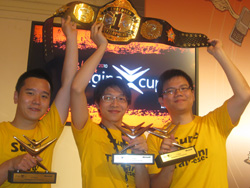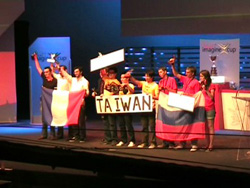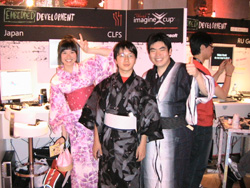WARSAW, Poland — July 9, 2010 — The Warsaw Opera House served as a picturesque backdrop for the closing ceremonies to this year’s Imagine Cup. The 400 students packed the theatre, joined by Microsoft executives, the Deputy Prime Minister of Poland and other esteemed guests, to learn which teams would be announced as Imagine Cup winners.
In first place of the Embedded Development category, taking home the title of Heavy Weight Embedded Technology Champion of the World, was Team Taiwan. Following in second and third place were Teams Russia and France, respectively.
These top teams caught the judges’ eyes because the students pushed the boundaries in how technology can apply to a real-life situation or need. Each group of students presented projects that were new, fresh and marketable with both real-world consumer and business appeal.
Creating a low-cost embedded system that is easy to install in a home or office was the winning Taiwan team with SmarterMeter. The system compiles detailed information on power consumption, including when and where power is most greatly consumed, to provide better configurations to help individuals or businesses save power and money.
Runner-up was Project Robonanny from Team Russia. This innovative robotic nanny, built by hand, introduces a new technology for the education of students. Robonanny connects modern achievements in information technology, robot technologies and the best teaching strategies for training and educating children.
The GERAS system, rounding out the top three, was Team France’s way to give back elderly people’s independence. Composed of an intelligent carpet and a motion detector, among other technologies, GERAS can detect the severity of an elderly person’s fall and notify 911 quickly to send help.

Team Taiwan show off the Heavy Weight Embedded Technology Champion belt.
“The unique thing about embedded devices is that they absolutely surround us, they form a kind of background music for technology and are integrated into every aspect of our life,” said Scott Davis, group marketing manager for Windows Embedded and the Embedded team captain. “Embedded devices augment the experiences that we have, which helps us to solve some of the world’s toughest problems.”
Jon Perera, general manager of Microsoft Education, summed up Imagine Cup competition and how it applies to students in the real world when addressing the audience, “You learned how to work as a team, you learned how to collaborate, you thought about the business complexity of how to bring these models to market.”
Feedback from this year’s judges was that they haven’t seen this level of quality and creativity before, noting the work was extraordinary. The teams in the Embedded Division were clear examples of the judges’ sentiments, pulling out all the stops and delivering tough competition to the ultimate champions.
Looking back at some of the Embedded Development competitors, each brought something special and unique. Not only are these students finding new and interesting ways of using embedded technology, they are continuing to push the limits in how they develop their individual projects. The six finalists were highlighted in more detail in a recent Imagine Cup feature article.

Embedded Development winners take the stage at Imagine Cup 2010.
Team Thailand: SuperLove Factory
The idea for this project stemmed from the students’ volunteer work with the blind. The Braille Eye, built on Windows CE 6.0 R3, generates a simulated image through a real-time display board and was created to help the blind visualize everyday objects and landscapes by touching and feeling a raise-dot display.
Team USA: Team Vaccine
Team Vaccine identified a simple but effective tool in assisting and tracking regional immunization plans across the globe. Built on Windows Embedded technologies, the vaccine tracker helps medical personnel record and track patient immunizations in remote regions of underdeveloped countries. The device identifies data using patient’s fingerprints, one of the most effective ideas in the competition. It runs on solar power with a built-in GPS.
Team Brazil: T.M.D
According to the UN, each person produces 800g to 1.5kg of garbage every day, which means about 6 million tons per day worldwide. Using sensor technology, T.M.D’s project, the Recycle-Box, is able to identify objects in the garbage such as paper, plastic, glass or metal. An embedded system is the ideal solution for this application, providing the necessary portability needed in a challenging condition. The Recycle-Box can be fixed to a mobile robot in order to move around the ground transporting one trash deposit to another.
Team Bulgaria: Krali Marko
The Bulgarian team set out to address environmental sustainability with its Green Monitor device, which points out the most effective working mode for car engines and also the best driving style to help lower emissions. Not only good for the environment, it also saves car owners money through lowered fuel consumption.
Team China: Carbon Footprint
To solve the deteriorating climate problems caused by excessive carbon dioxide emissions, the Chinese team established a personal carbon emission value calculating and trading platform. The Smart Carbon Footprint System calculates the amount of personal daily life carbon emissions, monitoring statistics and providing environmental protection suggestions to users. It can also encourage enterprises to produce low carbon products to reduce carbon emissions.
Team Germany: SmartTT
After being inspired by the recent earthquake in Haiti, the German team created SmartTT, an intelligent tracking system that enables NGOs to track supplies in areas of crisis. SmartTT helps users organize food, water or medical supplies, and track their current state and position using inexpensive RFID technology.
Team India: Wizminds
Truly showing the wide range of entries presented, Team India (first timers to Imagine Cup competition) developed the Wizitank, an unmanned ground vehicle used in combat and anti-terrorism activities to decipher the terrain ahead of it. The vehicle is mounted with sensors for evaluating the terrain and has Windows Embedded-built software and robotics for interpreting the data and path planning to offer a safe course of action.

Team Japan, dressed in traditional attire, is ready for the Imagine Cup World Ceremony.
Team Indonesia: Tselina
The Aaron system was designed to address the lack of education provided in rural areas of third-world countries, offering a cost-effective alternative solution to current aid work. Aaron is an embedded system for every education-based application built by developers. The system also enables people who are experts in their field to contribute their own information as a mentor.
Team Japan: CLFS
Inspired by the UN Goal to “Reduce Child Mortality and Improve Maternal Health,” CLFS from Tokyo designed the “Electronic Maternal and Child Health Handbook.” The handbook allows new mothers to record results of their medical checkups before, during and after pregnancy. It has ports for a thermometer, tape measure, weight tool, blood pressure meter and camera so expectant mothers are able to monitor their own health in the hope they can detect any abnormal change in their body.
Although the competition and festivities have come to an end, the momentum from the week will stay with the competitors for some time to come. With such a positive experience at the competition, many are already looking forward to returning to Imagine Cup 2011, which they learned will be New York. During the location announcement, the students received a surprise video message from First Lady Michelle Obama.
For additional Imagine Cup images, visit the Windows Embedded Flickr page and the official Imagine Cup Flickr page. A complete list of winners from all categories can be found on the official Imagine Cup website.




